Marketing Management: TOWS Analysis, Objectives, Marketing Mix Plan, Customer Service Improvement
VerifiedAdded on 2023/01/10
|13
|3748
|2
AI Summary
This report provides a comprehensive analysis of marketing management for Travelodge, including TOWS analysis, marketing objectives, marketing mix plan, and recommendations for customer service improvement.
Contribute Materials
Your contribution can guide someone’s learning journey. Share your
documents today.
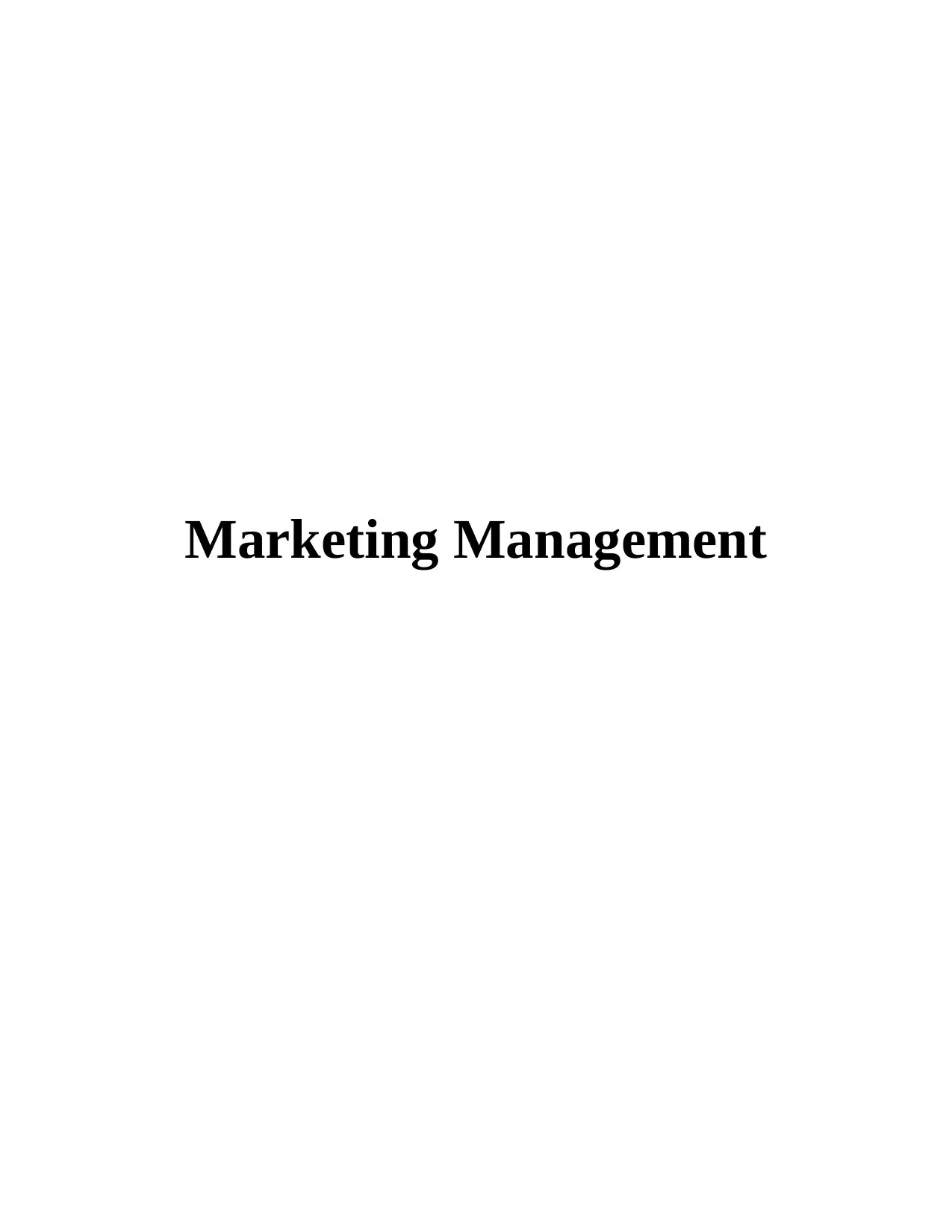
Marketing Management
Secure Best Marks with AI Grader
Need help grading? Try our AI Grader for instant feedback on your assignments.
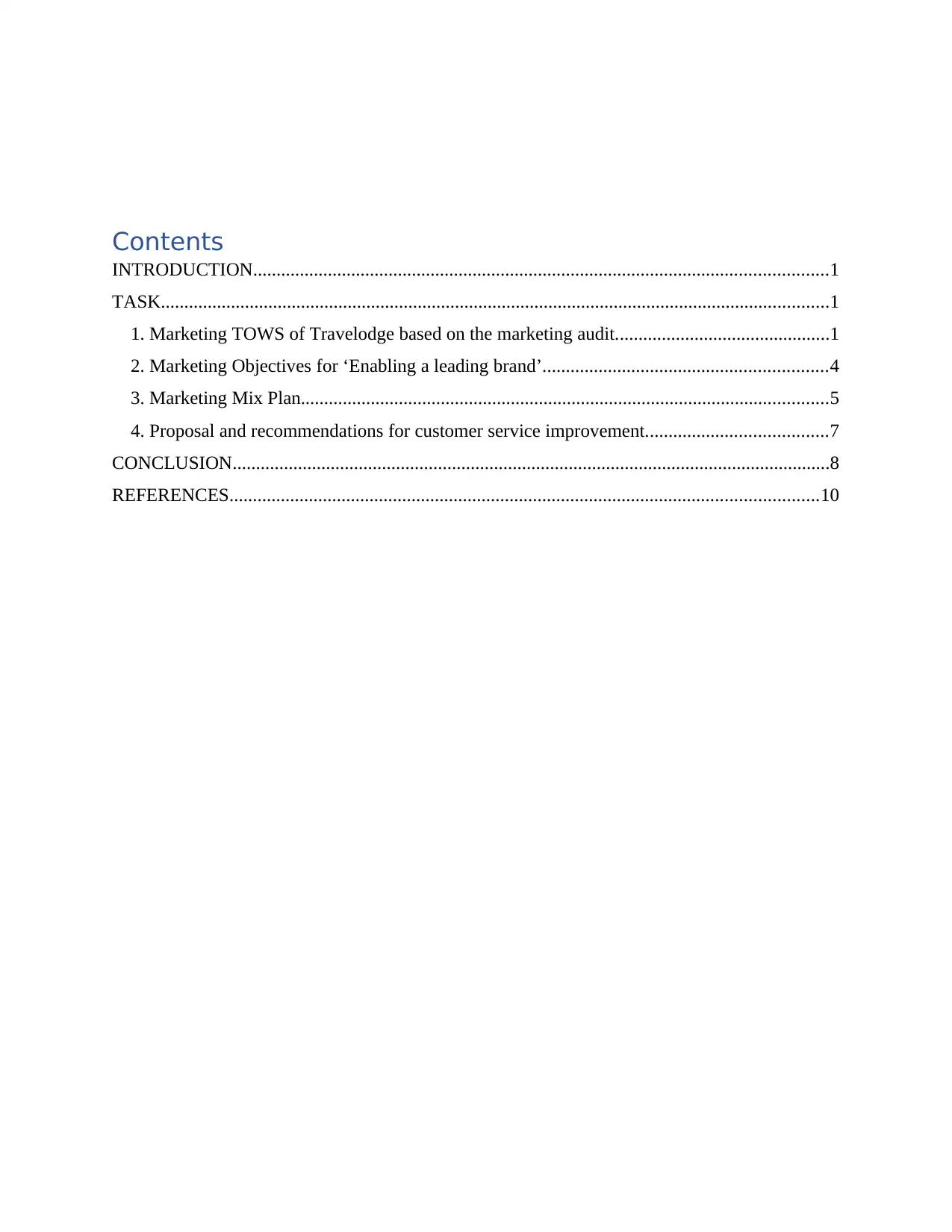
Contents
INTRODUCTION...........................................................................................................................1
TASK...............................................................................................................................................1
1. Marketing TOWS of Travelodge based on the marketing audit..............................................1
2. Marketing Objectives for ‘Enabling a leading brand’.............................................................4
3. Marketing Mix Plan.................................................................................................................5
4. Proposal and recommendations for customer service improvement.......................................7
CONCLUSION................................................................................................................................8
REFERENCES..............................................................................................................................10
INTRODUCTION...........................................................................................................................1
TASK...............................................................................................................................................1
1. Marketing TOWS of Travelodge based on the marketing audit..............................................1
2. Marketing Objectives for ‘Enabling a leading brand’.............................................................4
3. Marketing Mix Plan.................................................................................................................5
4. Proposal and recommendations for customer service improvement.......................................7
CONCLUSION................................................................................................................................8
REFERENCES..............................................................................................................................10

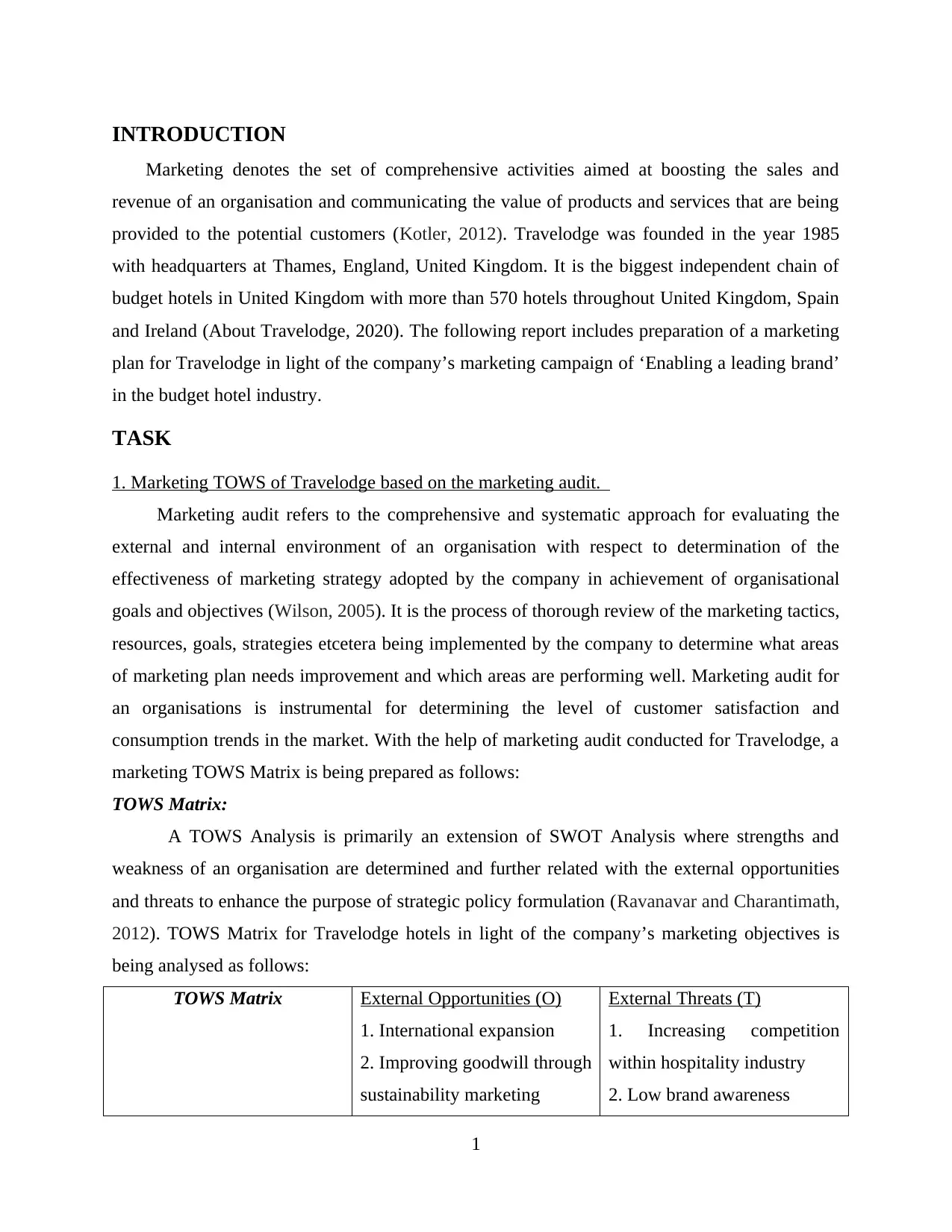
INTRODUCTION
Marketing denotes the set of comprehensive activities aimed at boosting the sales and
revenue of an organisation and communicating the value of products and services that are being
provided to the potential customers (Kotler, 2012). Travelodge was founded in the year 1985
with headquarters at Thames, England, United Kingdom. It is the biggest independent chain of
budget hotels in United Kingdom with more than 570 hotels throughout United Kingdom, Spain
and Ireland (About Travelodge, 2020). The following report includes preparation of a marketing
plan for Travelodge in light of the company’s marketing campaign of ‘Enabling a leading brand’
in the budget hotel industry.
TASK
1. Marketing TOWS of Travelodge based on the marketing audit.
Marketing audit refers to the comprehensive and systematic approach for evaluating the
external and internal environment of an organisation with respect to determination of the
effectiveness of marketing strategy adopted by the company in achievement of organisational
goals and objectives (Wilson, 2005). It is the process of thorough review of the marketing tactics,
resources, goals, strategies etcetera being implemented by the company to determine what areas
of marketing plan needs improvement and which areas are performing well. Marketing audit for
an organisations is instrumental for determining the level of customer satisfaction and
consumption trends in the market. With the help of marketing audit conducted for Travelodge, a
marketing TOWS Matrix is being prepared as follows:
TOWS Matrix:
A TOWS Analysis is primarily an extension of SWOT Analysis where strengths and
weakness of an organisation are determined and further related with the external opportunities
and threats to enhance the purpose of strategic policy formulation (Ravanavar and Charantimath,
2012). TOWS Matrix for Travelodge hotels in light of the company’s marketing objectives is
being analysed as follows:
TOWS Matrix External Opportunities (O)
1. International expansion
2. Improving goodwill through
sustainability marketing
External Threats (T)
1. Increasing competition
within hospitality industry
2. Low brand awareness
1
Marketing denotes the set of comprehensive activities aimed at boosting the sales and
revenue of an organisation and communicating the value of products and services that are being
provided to the potential customers (Kotler, 2012). Travelodge was founded in the year 1985
with headquarters at Thames, England, United Kingdom. It is the biggest independent chain of
budget hotels in United Kingdom with more than 570 hotels throughout United Kingdom, Spain
and Ireland (About Travelodge, 2020). The following report includes preparation of a marketing
plan for Travelodge in light of the company’s marketing campaign of ‘Enabling a leading brand’
in the budget hotel industry.
TASK
1. Marketing TOWS of Travelodge based on the marketing audit.
Marketing audit refers to the comprehensive and systematic approach for evaluating the
external and internal environment of an organisation with respect to determination of the
effectiveness of marketing strategy adopted by the company in achievement of organisational
goals and objectives (Wilson, 2005). It is the process of thorough review of the marketing tactics,
resources, goals, strategies etcetera being implemented by the company to determine what areas
of marketing plan needs improvement and which areas are performing well. Marketing audit for
an organisations is instrumental for determining the level of customer satisfaction and
consumption trends in the market. With the help of marketing audit conducted for Travelodge, a
marketing TOWS Matrix is being prepared as follows:
TOWS Matrix:
A TOWS Analysis is primarily an extension of SWOT Analysis where strengths and
weakness of an organisation are determined and further related with the external opportunities
and threats to enhance the purpose of strategic policy formulation (Ravanavar and Charantimath,
2012). TOWS Matrix for Travelodge hotels in light of the company’s marketing objectives is
being analysed as follows:
TOWS Matrix External Opportunities (O)
1. International expansion
2. Improving goodwill through
sustainability marketing
External Threats (T)
1. Increasing competition
within hospitality industry
2. Low brand awareness
1
Paraphrase This Document
Need a fresh take? Get an instant paraphrase of this document with our AI Paraphraser

3. Increasing millennial and
solo travelling
3. Global rise in level of
income and economic growth
Internal Strength (S)
1. Affordability
2. Travelodge Business
Account Card
3. Commitment to
sustainability
4. Extensive presence across
the United Kingdom
SO Strategy
1. Affordability and additional
services can be used for
targeting millennial customer
segment with low budgets.
2. Extensive presence of
company in United Kingdom
can be used to establish a
sustainable and leading brand
image.
ST Strategy
1. Sustainability marketing
can be a measure to mitigate
industrial competition.
2. By offering high quality of
service along with
affordability, customers in
high income group can be
targeted.
Internal Weakness (W)
1. Very basic and limited
customer service
2. Limited technology and
innovations
3. Overbooking and customer
frustration
WO Strategy
1. For targeting the millennial
customer segment, the
company needs to improve the
integration of technology and
social media marketing
campaign.
2. Aspects of additional
customer services such as free
wi-fi and breakfast with
advanced in-room technology
can be used for enabling high
customer satisfaction in
budget hotel industry for
millennial and solo travellers.
WT Strategy
1. Minimisation of extensive
use of overbooking policy.
2. Increasing technology and
innovations aspect for
mitigating competition within
the industry.
.
2
solo travelling
3. Global rise in level of
income and economic growth
Internal Strength (S)
1. Affordability
2. Travelodge Business
Account Card
3. Commitment to
sustainability
4. Extensive presence across
the United Kingdom
SO Strategy
1. Affordability and additional
services can be used for
targeting millennial customer
segment with low budgets.
2. Extensive presence of
company in United Kingdom
can be used to establish a
sustainable and leading brand
image.
ST Strategy
1. Sustainability marketing
can be a measure to mitigate
industrial competition.
2. By offering high quality of
service along with
affordability, customers in
high income group can be
targeted.
Internal Weakness (W)
1. Very basic and limited
customer service
2. Limited technology and
innovations
3. Overbooking and customer
frustration
WO Strategy
1. For targeting the millennial
customer segment, the
company needs to improve the
integration of technology and
social media marketing
campaign.
2. Aspects of additional
customer services such as free
wi-fi and breakfast with
advanced in-room technology
can be used for enabling high
customer satisfaction in
budget hotel industry for
millennial and solo travellers.
WT Strategy
1. Minimisation of extensive
use of overbooking policy.
2. Increasing technology and
innovations aspect for
mitigating competition within
the industry.
.
2
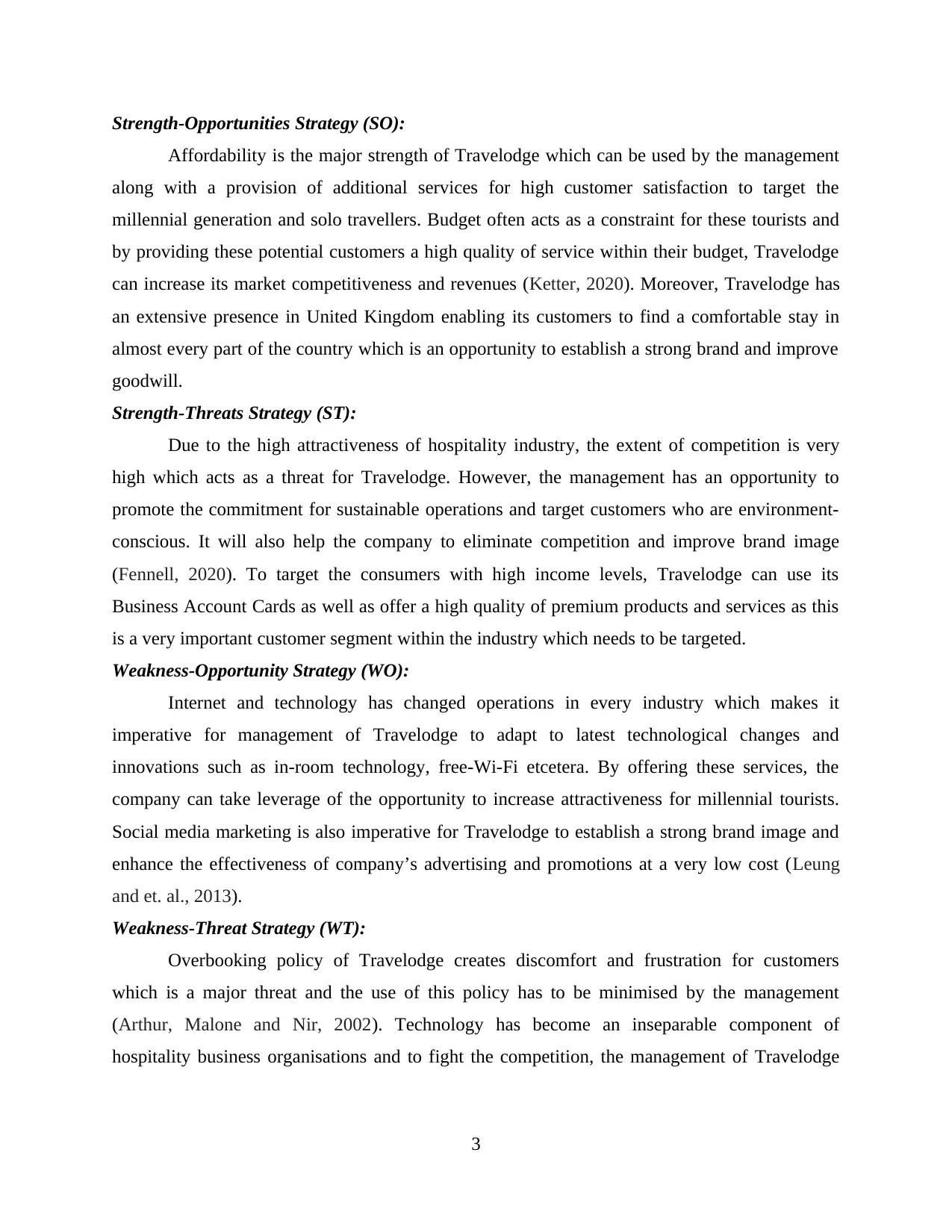
Strength-Opportunities Strategy (SO):
Affordability is the major strength of Travelodge which can be used by the management
along with a provision of additional services for high customer satisfaction to target the
millennial generation and solo travellers. Budget often acts as a constraint for these tourists and
by providing these potential customers a high quality of service within their budget, Travelodge
can increase its market competitiveness and revenues (Ketter, 2020). Moreover, Travelodge has
an extensive presence in United Kingdom enabling its customers to find a comfortable stay in
almost every part of the country which is an opportunity to establish a strong brand and improve
goodwill.
Strength-Threats Strategy (ST):
Due to the high attractiveness of hospitality industry, the extent of competition is very
high which acts as a threat for Travelodge. However, the management has an opportunity to
promote the commitment for sustainable operations and target customers who are environment-
conscious. It will also help the company to eliminate competition and improve brand image
(Fennell, 2020). To target the consumers with high income levels, Travelodge can use its
Business Account Cards as well as offer a high quality of premium products and services as this
is a very important customer segment within the industry which needs to be targeted.
Weakness-Opportunity Strategy (WO):
Internet and technology has changed operations in every industry which makes it
imperative for management of Travelodge to adapt to latest technological changes and
innovations such as in-room technology, free-Wi-Fi etcetera. By offering these services, the
company can take leverage of the opportunity to increase attractiveness for millennial tourists.
Social media marketing is also imperative for Travelodge to establish a strong brand image and
enhance the effectiveness of company’s advertising and promotions at a very low cost (Leung
and et. al., 2013).
Weakness-Threat Strategy (WT):
Overbooking policy of Travelodge creates discomfort and frustration for customers
which is a major threat and the use of this policy has to be minimised by the management
(Arthur, Malone and Nir, 2002). Technology has become an inseparable component of
hospitality business organisations and to fight the competition, the management of Travelodge
3
Affordability is the major strength of Travelodge which can be used by the management
along with a provision of additional services for high customer satisfaction to target the
millennial generation and solo travellers. Budget often acts as a constraint for these tourists and
by providing these potential customers a high quality of service within their budget, Travelodge
can increase its market competitiveness and revenues (Ketter, 2020). Moreover, Travelodge has
an extensive presence in United Kingdom enabling its customers to find a comfortable stay in
almost every part of the country which is an opportunity to establish a strong brand and improve
goodwill.
Strength-Threats Strategy (ST):
Due to the high attractiveness of hospitality industry, the extent of competition is very
high which acts as a threat for Travelodge. However, the management has an opportunity to
promote the commitment for sustainable operations and target customers who are environment-
conscious. It will also help the company to eliminate competition and improve brand image
(Fennell, 2020). To target the consumers with high income levels, Travelodge can use its
Business Account Cards as well as offer a high quality of premium products and services as this
is a very important customer segment within the industry which needs to be targeted.
Weakness-Opportunity Strategy (WO):
Internet and technology has changed operations in every industry which makes it
imperative for management of Travelodge to adapt to latest technological changes and
innovations such as in-room technology, free-Wi-Fi etcetera. By offering these services, the
company can take leverage of the opportunity to increase attractiveness for millennial tourists.
Social media marketing is also imperative for Travelodge to establish a strong brand image and
enhance the effectiveness of company’s advertising and promotions at a very low cost (Leung
and et. al., 2013).
Weakness-Threat Strategy (WT):
Overbooking policy of Travelodge creates discomfort and frustration for customers
which is a major threat and the use of this policy has to be minimised by the management
(Arthur, Malone and Nir, 2002). Technology has become an inseparable component of
hospitality business organisations and to fight the competition, the management of Travelodge
3
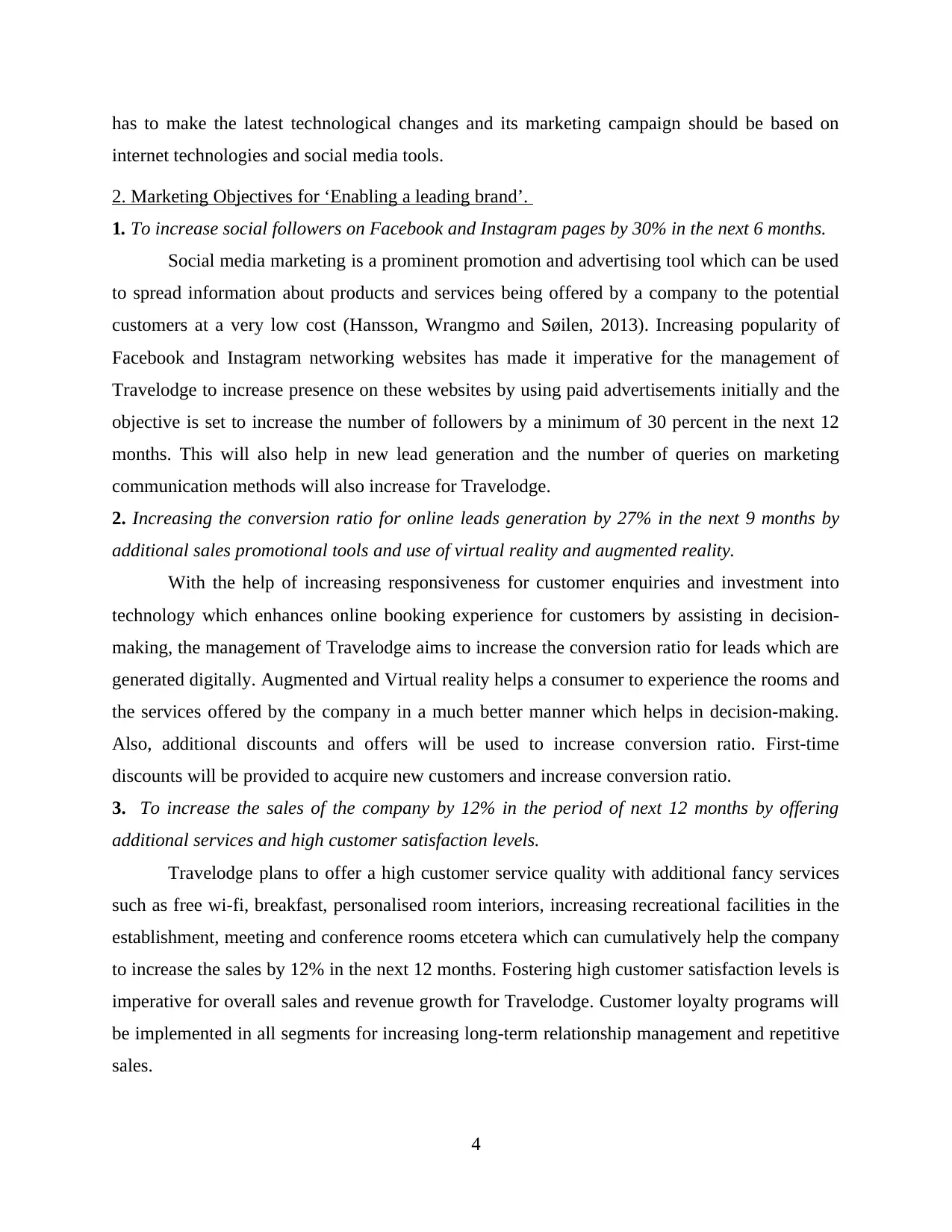
has to make the latest technological changes and its marketing campaign should be based on
internet technologies and social media tools.
2. Marketing Objectives for ‘Enabling a leading brand’.
1. To increase social followers on Facebook and Instagram pages by 30% in the next 6 months.
Social media marketing is a prominent promotion and advertising tool which can be used
to spread information about products and services being offered by a company to the potential
customers at a very low cost (Hansson, Wrangmo and Søilen, 2013). Increasing popularity of
Facebook and Instagram networking websites has made it imperative for the management of
Travelodge to increase presence on these websites by using paid advertisements initially and the
objective is set to increase the number of followers by a minimum of 30 percent in the next 12
months. This will also help in new lead generation and the number of queries on marketing
communication methods will also increase for Travelodge.
2. Increasing the conversion ratio for online leads generation by 27% in the next 9 months by
additional sales promotional tools and use of virtual reality and augmented reality.
With the help of increasing responsiveness for customer enquiries and investment into
technology which enhances online booking experience for customers by assisting in decision-
making, the management of Travelodge aims to increase the conversion ratio for leads which are
generated digitally. Augmented and Virtual reality helps a consumer to experience the rooms and
the services offered by the company in a much better manner which helps in decision-making.
Also, additional discounts and offers will be used to increase conversion ratio. First-time
discounts will be provided to acquire new customers and increase conversion ratio.
3. To increase the sales of the company by 12% in the period of next 12 months by offering
additional services and high customer satisfaction levels.
Travelodge plans to offer a high customer service quality with additional fancy services
such as free wi-fi, breakfast, personalised room interiors, increasing recreational facilities in the
establishment, meeting and conference rooms etcetera which can cumulatively help the company
to increase the sales by 12% in the next 12 months. Fostering high customer satisfaction levels is
imperative for overall sales and revenue growth for Travelodge. Customer loyalty programs will
be implemented in all segments for increasing long-term relationship management and repetitive
sales.
4
internet technologies and social media tools.
2. Marketing Objectives for ‘Enabling a leading brand’.
1. To increase social followers on Facebook and Instagram pages by 30% in the next 6 months.
Social media marketing is a prominent promotion and advertising tool which can be used
to spread information about products and services being offered by a company to the potential
customers at a very low cost (Hansson, Wrangmo and Søilen, 2013). Increasing popularity of
Facebook and Instagram networking websites has made it imperative for the management of
Travelodge to increase presence on these websites by using paid advertisements initially and the
objective is set to increase the number of followers by a minimum of 30 percent in the next 12
months. This will also help in new lead generation and the number of queries on marketing
communication methods will also increase for Travelodge.
2. Increasing the conversion ratio for online leads generation by 27% in the next 9 months by
additional sales promotional tools and use of virtual reality and augmented reality.
With the help of increasing responsiveness for customer enquiries and investment into
technology which enhances online booking experience for customers by assisting in decision-
making, the management of Travelodge aims to increase the conversion ratio for leads which are
generated digitally. Augmented and Virtual reality helps a consumer to experience the rooms and
the services offered by the company in a much better manner which helps in decision-making.
Also, additional discounts and offers will be used to increase conversion ratio. First-time
discounts will be provided to acquire new customers and increase conversion ratio.
3. To increase the sales of the company by 12% in the period of next 12 months by offering
additional services and high customer satisfaction levels.
Travelodge plans to offer a high customer service quality with additional fancy services
such as free wi-fi, breakfast, personalised room interiors, increasing recreational facilities in the
establishment, meeting and conference rooms etcetera which can cumulatively help the company
to increase the sales by 12% in the next 12 months. Fostering high customer satisfaction levels is
imperative for overall sales and revenue growth for Travelodge. Customer loyalty programs will
be implemented in all segments for increasing long-term relationship management and repetitive
sales.
4
Secure Best Marks with AI Grader
Need help grading? Try our AI Grader for instant feedback on your assignments.
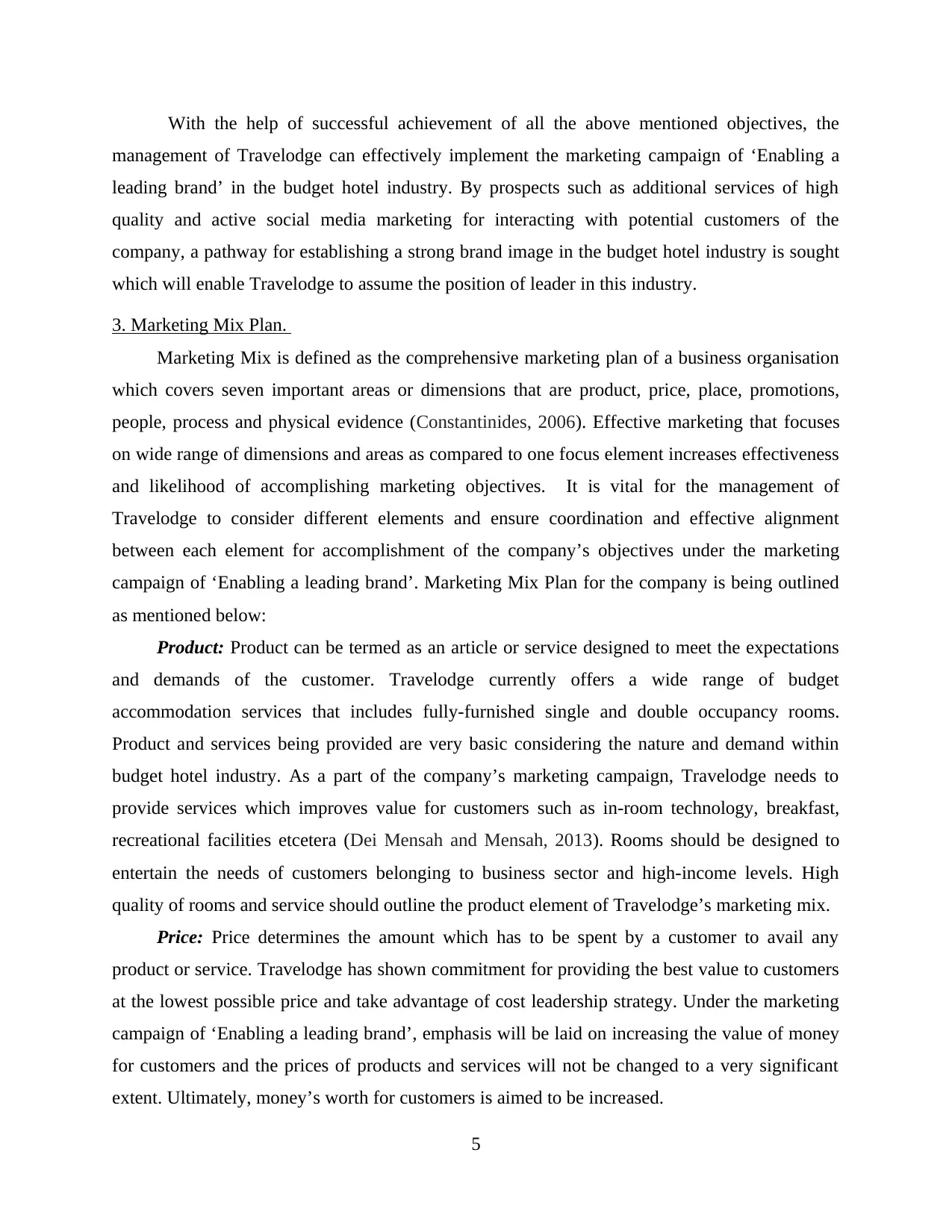
With the help of successful achievement of all the above mentioned objectives, the
management of Travelodge can effectively implement the marketing campaign of ‘Enabling a
leading brand’ in the budget hotel industry. By prospects such as additional services of high
quality and active social media marketing for interacting with potential customers of the
company, a pathway for establishing a strong brand image in the budget hotel industry is sought
which will enable Travelodge to assume the position of leader in this industry.
3. Marketing Mix Plan.
Marketing Mix is defined as the comprehensive marketing plan of a business organisation
which covers seven important areas or dimensions that are product, price, place, promotions,
people, process and physical evidence (Constantinides, 2006). Effective marketing that focuses
on wide range of dimensions and areas as compared to one focus element increases effectiveness
and likelihood of accomplishing marketing objectives. It is vital for the management of
Travelodge to consider different elements and ensure coordination and effective alignment
between each element for accomplishment of the company’s objectives under the marketing
campaign of ‘Enabling a leading brand’. Marketing Mix Plan for the company is being outlined
as mentioned below:
Product: Product can be termed as an article or service designed to meet the expectations
and demands of the customer. Travelodge currently offers a wide range of budget
accommodation services that includes fully-furnished single and double occupancy rooms.
Product and services being provided are very basic considering the nature and demand within
budget hotel industry. As a part of the company’s marketing campaign, Travelodge needs to
provide services which improves value for customers such as in-room technology, breakfast,
recreational facilities etcetera (Dei Mensah and Mensah, 2013). Rooms should be designed to
entertain the needs of customers belonging to business sector and high-income levels. High
quality of rooms and service should outline the product element of Travelodge’s marketing mix.
Price: Price determines the amount which has to be spent by a customer to avail any
product or service. Travelodge has shown commitment for providing the best value to customers
at the lowest possible price and take advantage of cost leadership strategy. Under the marketing
campaign of ‘Enabling a leading brand’, emphasis will be laid on increasing the value of money
for customers and the prices of products and services will not be changed to a very significant
extent. Ultimately, money’s worth for customers is aimed to be increased.
5
management of Travelodge can effectively implement the marketing campaign of ‘Enabling a
leading brand’ in the budget hotel industry. By prospects such as additional services of high
quality and active social media marketing for interacting with potential customers of the
company, a pathway for establishing a strong brand image in the budget hotel industry is sought
which will enable Travelodge to assume the position of leader in this industry.
3. Marketing Mix Plan.
Marketing Mix is defined as the comprehensive marketing plan of a business organisation
which covers seven important areas or dimensions that are product, price, place, promotions,
people, process and physical evidence (Constantinides, 2006). Effective marketing that focuses
on wide range of dimensions and areas as compared to one focus element increases effectiveness
and likelihood of accomplishing marketing objectives. It is vital for the management of
Travelodge to consider different elements and ensure coordination and effective alignment
between each element for accomplishment of the company’s objectives under the marketing
campaign of ‘Enabling a leading brand’. Marketing Mix Plan for the company is being outlined
as mentioned below:
Product: Product can be termed as an article or service designed to meet the expectations
and demands of the customer. Travelodge currently offers a wide range of budget
accommodation services that includes fully-furnished single and double occupancy rooms.
Product and services being provided are very basic considering the nature and demand within
budget hotel industry. As a part of the company’s marketing campaign, Travelodge needs to
provide services which improves value for customers such as in-room technology, breakfast,
recreational facilities etcetera (Dei Mensah and Mensah, 2013). Rooms should be designed to
entertain the needs of customers belonging to business sector and high-income levels. High
quality of rooms and service should outline the product element of Travelodge’s marketing mix.
Price: Price determines the amount which has to be spent by a customer to avail any
product or service. Travelodge has shown commitment for providing the best value to customers
at the lowest possible price and take advantage of cost leadership strategy. Under the marketing
campaign of ‘Enabling a leading brand’, emphasis will be laid on increasing the value of money
for customers and the prices of products and services will not be changed to a very significant
extent. Ultimately, money’s worth for customers is aimed to be increased.
5
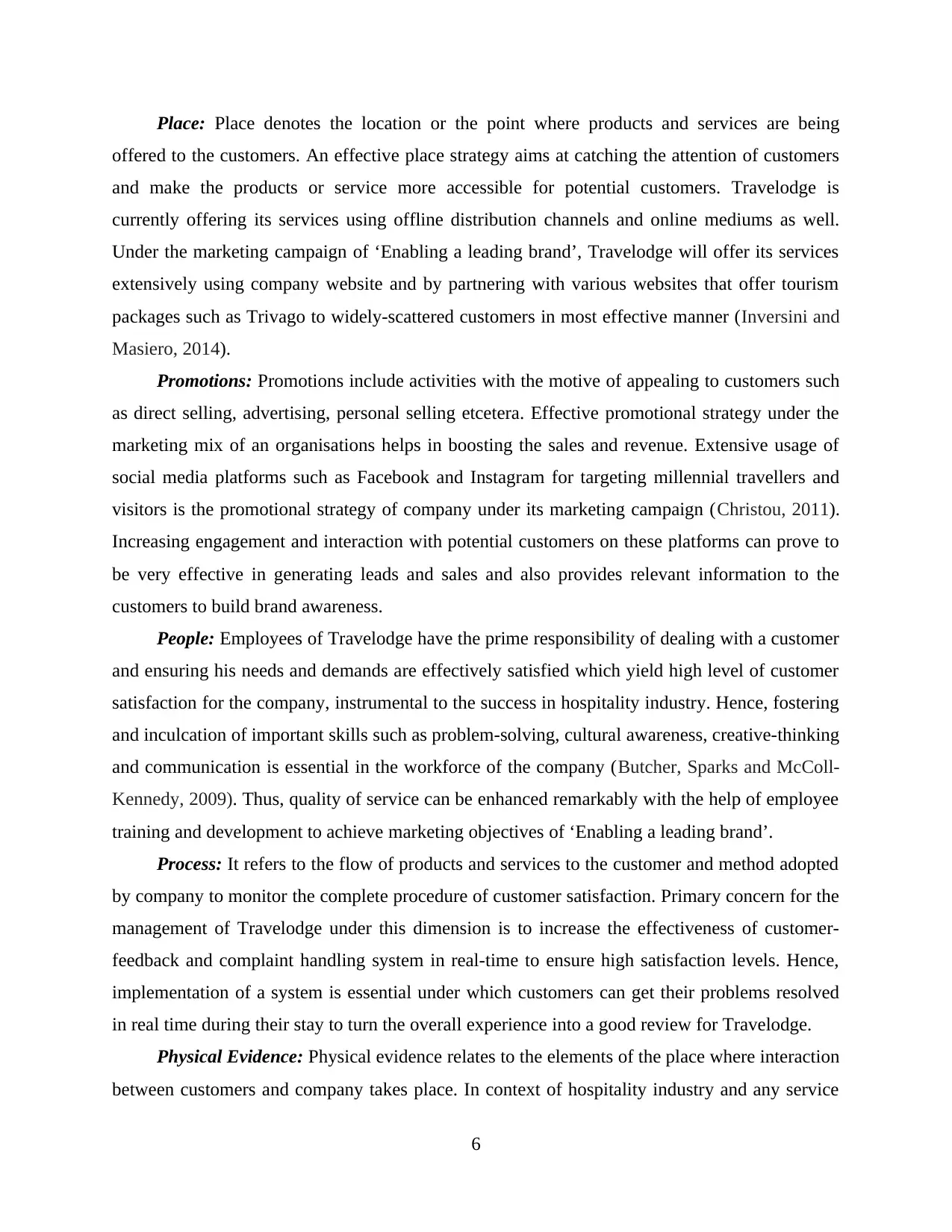
Place: Place denotes the location or the point where products and services are being
offered to the customers. An effective place strategy aims at catching the attention of customers
and make the products or service more accessible for potential customers. Travelodge is
currently offering its services using offline distribution channels and online mediums as well.
Under the marketing campaign of ‘Enabling a leading brand’, Travelodge will offer its services
extensively using company website and by partnering with various websites that offer tourism
packages such as Trivago to widely-scattered customers in most effective manner (Inversini and
Masiero, 2014).
Promotions: Promotions include activities with the motive of appealing to customers such
as direct selling, advertising, personal selling etcetera. Effective promotional strategy under the
marketing mix of an organisations helps in boosting the sales and revenue. Extensive usage of
social media platforms such as Facebook and Instagram for targeting millennial travellers and
visitors is the promotional strategy of company under its marketing campaign (Christou, 2011).
Increasing engagement and interaction with potential customers on these platforms can prove to
be very effective in generating leads and sales and also provides relevant information to the
customers to build brand awareness.
People: Employees of Travelodge have the prime responsibility of dealing with a customer
and ensuring his needs and demands are effectively satisfied which yield high level of customer
satisfaction for the company, instrumental to the success in hospitality industry. Hence, fostering
and inculcation of important skills such as problem-solving, cultural awareness, creative-thinking
and communication is essential in the workforce of the company (Butcher, Sparks and McColl-
Kennedy, 2009). Thus, quality of service can be enhanced remarkably with the help of employee
training and development to achieve marketing objectives of ‘Enabling a leading brand’.
Process: It refers to the flow of products and services to the customer and method adopted
by company to monitor the complete procedure of customer satisfaction. Primary concern for the
management of Travelodge under this dimension is to increase the effectiveness of customer-
feedback and complaint handling system in real-time to ensure high satisfaction levels. Hence,
implementation of a system is essential under which customers can get their problems resolved
in real time during their stay to turn the overall experience into a good review for Travelodge.
Physical Evidence: Physical evidence relates to the elements of the place where interaction
between customers and company takes place. In context of hospitality industry and any service
6
offered to the customers. An effective place strategy aims at catching the attention of customers
and make the products or service more accessible for potential customers. Travelodge is
currently offering its services using offline distribution channels and online mediums as well.
Under the marketing campaign of ‘Enabling a leading brand’, Travelodge will offer its services
extensively using company website and by partnering with various websites that offer tourism
packages such as Trivago to widely-scattered customers in most effective manner (Inversini and
Masiero, 2014).
Promotions: Promotions include activities with the motive of appealing to customers such
as direct selling, advertising, personal selling etcetera. Effective promotional strategy under the
marketing mix of an organisations helps in boosting the sales and revenue. Extensive usage of
social media platforms such as Facebook and Instagram for targeting millennial travellers and
visitors is the promotional strategy of company under its marketing campaign (Christou, 2011).
Increasing engagement and interaction with potential customers on these platforms can prove to
be very effective in generating leads and sales and also provides relevant information to the
customers to build brand awareness.
People: Employees of Travelodge have the prime responsibility of dealing with a customer
and ensuring his needs and demands are effectively satisfied which yield high level of customer
satisfaction for the company, instrumental to the success in hospitality industry. Hence, fostering
and inculcation of important skills such as problem-solving, cultural awareness, creative-thinking
and communication is essential in the workforce of the company (Butcher, Sparks and McColl-
Kennedy, 2009). Thus, quality of service can be enhanced remarkably with the help of employee
training and development to achieve marketing objectives of ‘Enabling a leading brand’.
Process: It refers to the flow of products and services to the customer and method adopted
by company to monitor the complete procedure of customer satisfaction. Primary concern for the
management of Travelodge under this dimension is to increase the effectiveness of customer-
feedback and complaint handling system in real-time to ensure high satisfaction levels. Hence,
implementation of a system is essential under which customers can get their problems resolved
in real time during their stay to turn the overall experience into a good review for Travelodge.
Physical Evidence: Physical evidence relates to the elements of the place where interaction
between customers and company takes place. In context of hospitality industry and any service
6
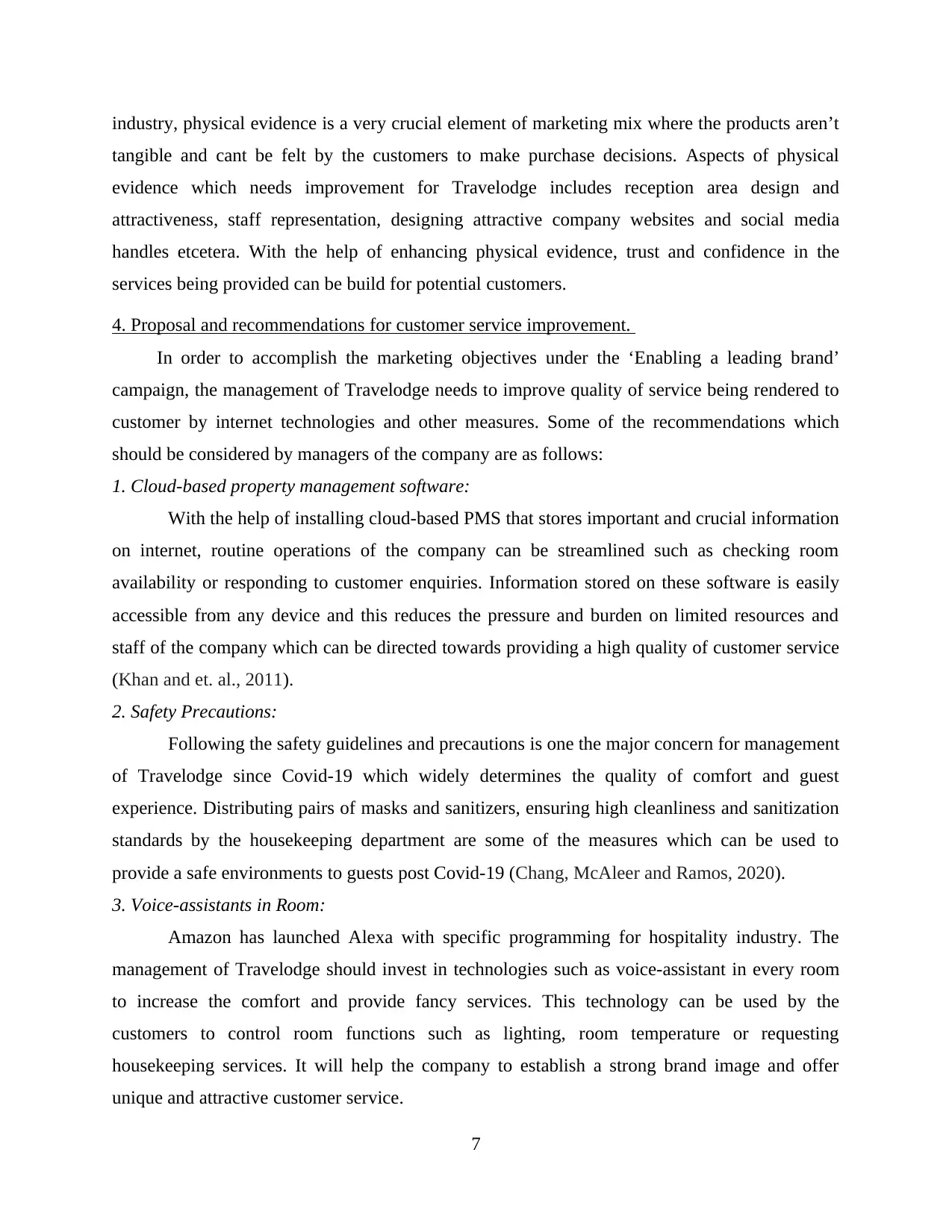
industry, physical evidence is a very crucial element of marketing mix where the products aren’t
tangible and cant be felt by the customers to make purchase decisions. Aspects of physical
evidence which needs improvement for Travelodge includes reception area design and
attractiveness, staff representation, designing attractive company websites and social media
handles etcetera. With the help of enhancing physical evidence, trust and confidence in the
services being provided can be build for potential customers.
4. Proposal and recommendations for customer service improvement.
In order to accomplish the marketing objectives under the ‘Enabling a leading brand’
campaign, the management of Travelodge needs to improve quality of service being rendered to
customer by internet technologies and other measures. Some of the recommendations which
should be considered by managers of the company are as follows:
1. Cloud-based property management software:
With the help of installing cloud-based PMS that stores important and crucial information
on internet, routine operations of the company can be streamlined such as checking room
availability or responding to customer enquiries. Information stored on these software is easily
accessible from any device and this reduces the pressure and burden on limited resources and
staff of the company which can be directed towards providing a high quality of customer service
(Khan and et. al., 2011).
2. Safety Precautions:
Following the safety guidelines and precautions is one the major concern for management
of Travelodge since Covid-19 which widely determines the quality of comfort and guest
experience. Distributing pairs of masks and sanitizers, ensuring high cleanliness and sanitization
standards by the housekeeping department are some of the measures which can be used to
provide a safe environments to guests post Covid-19 (Chang, McAleer and Ramos, 2020).
3. Voice-assistants in Room:
Amazon has launched Alexa with specific programming for hospitality industry. The
management of Travelodge should invest in technologies such as voice-assistant in every room
to increase the comfort and provide fancy services. This technology can be used by the
customers to control room functions such as lighting, room temperature or requesting
housekeeping services. It will help the company to establish a strong brand image and offer
unique and attractive customer service.
7
tangible and cant be felt by the customers to make purchase decisions. Aspects of physical
evidence which needs improvement for Travelodge includes reception area design and
attractiveness, staff representation, designing attractive company websites and social media
handles etcetera. With the help of enhancing physical evidence, trust and confidence in the
services being provided can be build for potential customers.
4. Proposal and recommendations for customer service improvement.
In order to accomplish the marketing objectives under the ‘Enabling a leading brand’
campaign, the management of Travelodge needs to improve quality of service being rendered to
customer by internet technologies and other measures. Some of the recommendations which
should be considered by managers of the company are as follows:
1. Cloud-based property management software:
With the help of installing cloud-based PMS that stores important and crucial information
on internet, routine operations of the company can be streamlined such as checking room
availability or responding to customer enquiries. Information stored on these software is easily
accessible from any device and this reduces the pressure and burden on limited resources and
staff of the company which can be directed towards providing a high quality of customer service
(Khan and et. al., 2011).
2. Safety Precautions:
Following the safety guidelines and precautions is one the major concern for management
of Travelodge since Covid-19 which widely determines the quality of comfort and guest
experience. Distributing pairs of masks and sanitizers, ensuring high cleanliness and sanitization
standards by the housekeeping department are some of the measures which can be used to
provide a safe environments to guests post Covid-19 (Chang, McAleer and Ramos, 2020).
3. Voice-assistants in Room:
Amazon has launched Alexa with specific programming for hospitality industry. The
management of Travelodge should invest in technologies such as voice-assistant in every room
to increase the comfort and provide fancy services. This technology can be used by the
customers to control room functions such as lighting, room temperature or requesting
housekeeping services. It will help the company to establish a strong brand image and offer
unique and attractive customer service.
7
Paraphrase This Document
Need a fresh take? Get an instant paraphrase of this document with our AI Paraphraser
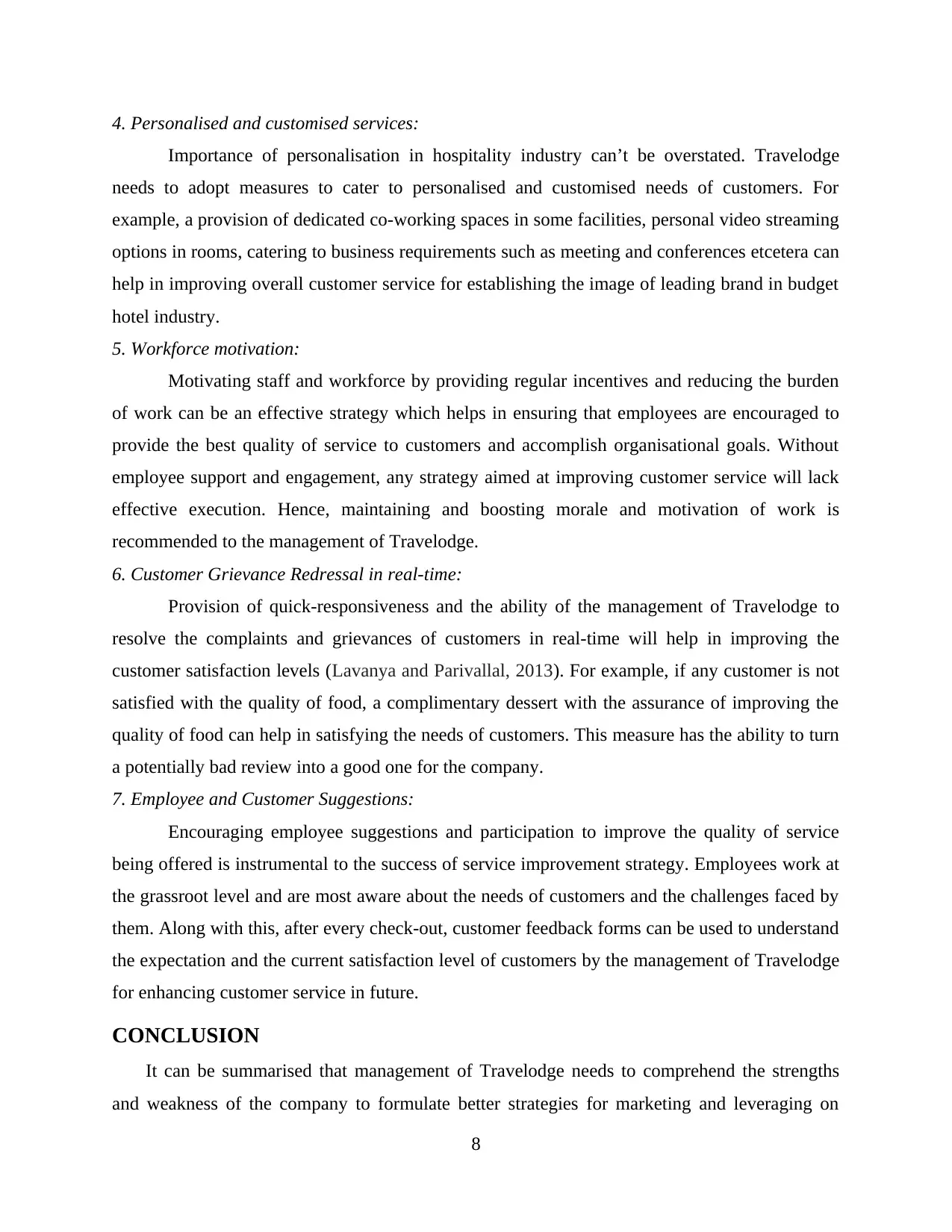
4. Personalised and customised services:
Importance of personalisation in hospitality industry can’t be overstated. Travelodge
needs to adopt measures to cater to personalised and customised needs of customers. For
example, a provision of dedicated co-working spaces in some facilities, personal video streaming
options in rooms, catering to business requirements such as meeting and conferences etcetera can
help in improving overall customer service for establishing the image of leading brand in budget
hotel industry.
5. Workforce motivation:
Motivating staff and workforce by providing regular incentives and reducing the burden
of work can be an effective strategy which helps in ensuring that employees are encouraged to
provide the best quality of service to customers and accomplish organisational goals. Without
employee support and engagement, any strategy aimed at improving customer service will lack
effective execution. Hence, maintaining and boosting morale and motivation of work is
recommended to the management of Travelodge.
6. Customer Grievance Redressal in real-time:
Provision of quick-responsiveness and the ability of the management of Travelodge to
resolve the complaints and grievances of customers in real-time will help in improving the
customer satisfaction levels (Lavanya and Parivallal, 2013). For example, if any customer is not
satisfied with the quality of food, a complimentary dessert with the assurance of improving the
quality of food can help in satisfying the needs of customers. This measure has the ability to turn
a potentially bad review into a good one for the company.
7. Employee and Customer Suggestions:
Encouraging employee suggestions and participation to improve the quality of service
being offered is instrumental to the success of service improvement strategy. Employees work at
the grassroot level and are most aware about the needs of customers and the challenges faced by
them. Along with this, after every check-out, customer feedback forms can be used to understand
the expectation and the current satisfaction level of customers by the management of Travelodge
for enhancing customer service in future.
CONCLUSION
It can be summarised that management of Travelodge needs to comprehend the strengths
and weakness of the company to formulate better strategies for marketing and leveraging on
8
Importance of personalisation in hospitality industry can’t be overstated. Travelodge
needs to adopt measures to cater to personalised and customised needs of customers. For
example, a provision of dedicated co-working spaces in some facilities, personal video streaming
options in rooms, catering to business requirements such as meeting and conferences etcetera can
help in improving overall customer service for establishing the image of leading brand in budget
hotel industry.
5. Workforce motivation:
Motivating staff and workforce by providing regular incentives and reducing the burden
of work can be an effective strategy which helps in ensuring that employees are encouraged to
provide the best quality of service to customers and accomplish organisational goals. Without
employee support and engagement, any strategy aimed at improving customer service will lack
effective execution. Hence, maintaining and boosting morale and motivation of work is
recommended to the management of Travelodge.
6. Customer Grievance Redressal in real-time:
Provision of quick-responsiveness and the ability of the management of Travelodge to
resolve the complaints and grievances of customers in real-time will help in improving the
customer satisfaction levels (Lavanya and Parivallal, 2013). For example, if any customer is not
satisfied with the quality of food, a complimentary dessert with the assurance of improving the
quality of food can help in satisfying the needs of customers. This measure has the ability to turn
a potentially bad review into a good one for the company.
7. Employee and Customer Suggestions:
Encouraging employee suggestions and participation to improve the quality of service
being offered is instrumental to the success of service improvement strategy. Employees work at
the grassroot level and are most aware about the needs of customers and the challenges faced by
them. Along with this, after every check-out, customer feedback forms can be used to understand
the expectation and the current satisfaction level of customers by the management of Travelodge
for enhancing customer service in future.
CONCLUSION
It can be summarised that management of Travelodge needs to comprehend the strengths
and weakness of the company to formulate better strategies for marketing and leveraging on
8
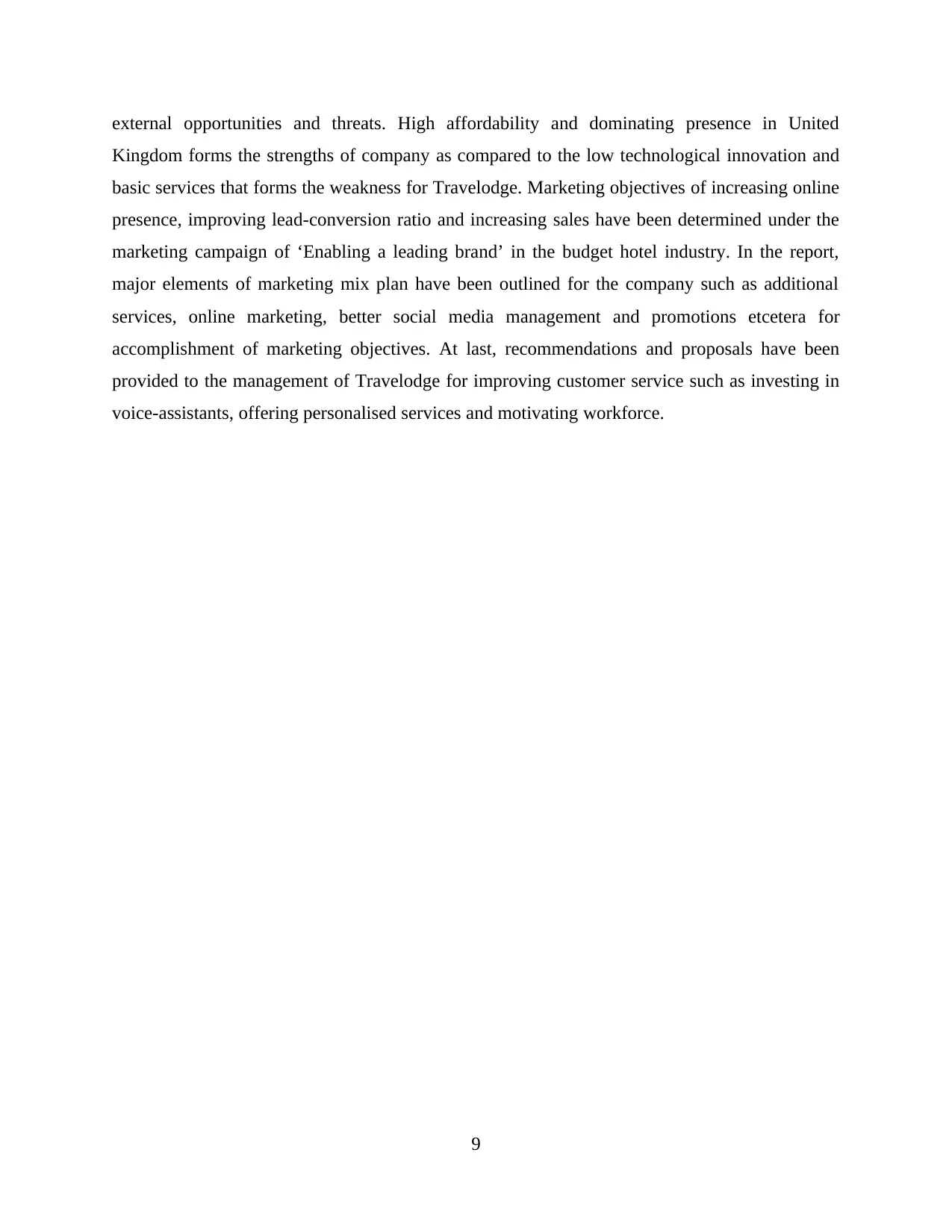
external opportunities and threats. High affordability and dominating presence in United
Kingdom forms the strengths of company as compared to the low technological innovation and
basic services that forms the weakness for Travelodge. Marketing objectives of increasing online
presence, improving lead-conversion ratio and increasing sales have been determined under the
marketing campaign of ‘Enabling a leading brand’ in the budget hotel industry. In the report,
major elements of marketing mix plan have been outlined for the company such as additional
services, online marketing, better social media management and promotions etcetera for
accomplishment of marketing objectives. At last, recommendations and proposals have been
provided to the management of Travelodge for improving customer service such as investing in
voice-assistants, offering personalised services and motivating workforce.
9
Kingdom forms the strengths of company as compared to the low technological innovation and
basic services that forms the weakness for Travelodge. Marketing objectives of increasing online
presence, improving lead-conversion ratio and increasing sales have been determined under the
marketing campaign of ‘Enabling a leading brand’ in the budget hotel industry. In the report,
major elements of marketing mix plan have been outlined for the company such as additional
services, online marketing, better social media management and promotions etcetera for
accomplishment of marketing objectives. At last, recommendations and proposals have been
provided to the management of Travelodge for improving customer service such as investing in
voice-assistants, offering personalised services and motivating workforce.
9
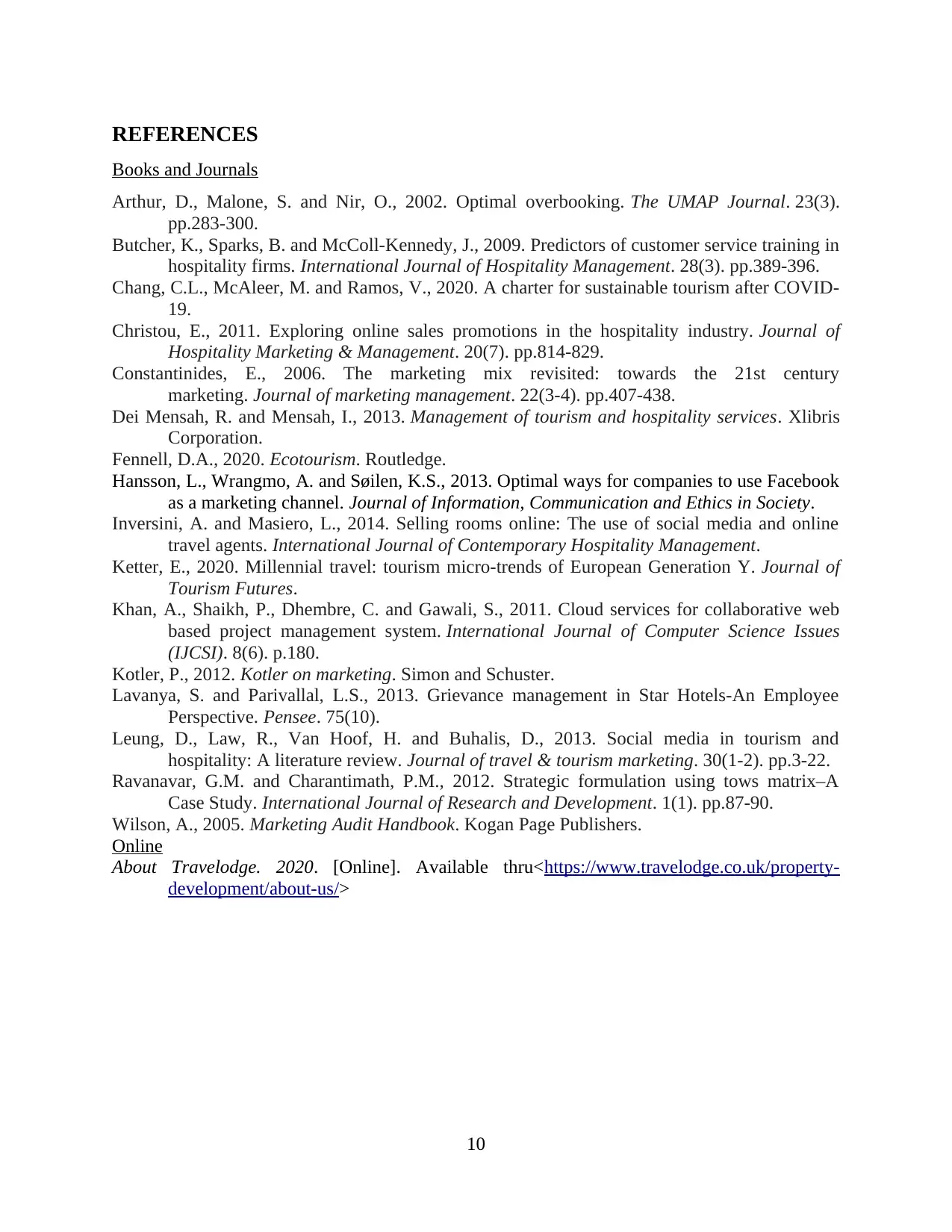
REFERENCES
Books and Journals
Arthur, D., Malone, S. and Nir, O., 2002. Optimal overbooking. The UMAP Journal. 23(3).
pp.283-300.
Butcher, K., Sparks, B. and McColl-Kennedy, J., 2009. Predictors of customer service training in
hospitality firms. International Journal of Hospitality Management. 28(3). pp.389-396.
Chang, C.L., McAleer, M. and Ramos, V., 2020. A charter for sustainable tourism after COVID-
19.
Christou, E., 2011. Exploring online sales promotions in the hospitality industry. Journal of
Hospitality Marketing & Management. 20(7). pp.814-829.
Constantinides, E., 2006. The marketing mix revisited: towards the 21st century
marketing. Journal of marketing management. 22(3-4). pp.407-438.
Dei Mensah, R. and Mensah, I., 2013. Management of tourism and hospitality services. Xlibris
Corporation.
Fennell, D.A., 2020. Ecotourism. Routledge.
Hansson, L., Wrangmo, A. and Søilen, K.S., 2013. Optimal ways for companies to use Facebook
as a marketing channel. Journal of Information, Communication and Ethics in Society.
Inversini, A. and Masiero, L., 2014. Selling rooms online: The use of social media and online
travel agents. International Journal of Contemporary Hospitality Management.
Ketter, E., 2020. Millennial travel: tourism micro-trends of European Generation Y. Journal of
Tourism Futures.
Khan, A., Shaikh, P., Dhembre, C. and Gawali, S., 2011. Cloud services for collaborative web
based project management system. International Journal of Computer Science Issues
(IJCSI). 8(6). p.180.
Kotler, P., 2012. Kotler on marketing. Simon and Schuster.
Lavanya, S. and Parivallal, L.S., 2013. Grievance management in Star Hotels-An Employee
Perspective. Pensee. 75(10).
Leung, D., Law, R., Van Hoof, H. and Buhalis, D., 2013. Social media in tourism and
hospitality: A literature review. Journal of travel & tourism marketing. 30(1-2). pp.3-22.
Ravanavar, G.M. and Charantimath, P.M., 2012. Strategic formulation using tows matrix–A
Case Study. International Journal of Research and Development. 1(1). pp.87-90.
Wilson, A., 2005. Marketing Audit Handbook. Kogan Page Publishers.
Online
About Travelodge. 2020. [Online]. Available thru<https://www.travelodge.co.uk/property-
development/about-us/>
10
Books and Journals
Arthur, D., Malone, S. and Nir, O., 2002. Optimal overbooking. The UMAP Journal. 23(3).
pp.283-300.
Butcher, K., Sparks, B. and McColl-Kennedy, J., 2009. Predictors of customer service training in
hospitality firms. International Journal of Hospitality Management. 28(3). pp.389-396.
Chang, C.L., McAleer, M. and Ramos, V., 2020. A charter for sustainable tourism after COVID-
19.
Christou, E., 2011. Exploring online sales promotions in the hospitality industry. Journal of
Hospitality Marketing & Management. 20(7). pp.814-829.
Constantinides, E., 2006. The marketing mix revisited: towards the 21st century
marketing. Journal of marketing management. 22(3-4). pp.407-438.
Dei Mensah, R. and Mensah, I., 2013. Management of tourism and hospitality services. Xlibris
Corporation.
Fennell, D.A., 2020. Ecotourism. Routledge.
Hansson, L., Wrangmo, A. and Søilen, K.S., 2013. Optimal ways for companies to use Facebook
as a marketing channel. Journal of Information, Communication and Ethics in Society.
Inversini, A. and Masiero, L., 2014. Selling rooms online: The use of social media and online
travel agents. International Journal of Contemporary Hospitality Management.
Ketter, E., 2020. Millennial travel: tourism micro-trends of European Generation Y. Journal of
Tourism Futures.
Khan, A., Shaikh, P., Dhembre, C. and Gawali, S., 2011. Cloud services for collaborative web
based project management system. International Journal of Computer Science Issues
(IJCSI). 8(6). p.180.
Kotler, P., 2012. Kotler on marketing. Simon and Schuster.
Lavanya, S. and Parivallal, L.S., 2013. Grievance management in Star Hotels-An Employee
Perspective. Pensee. 75(10).
Leung, D., Law, R., Van Hoof, H. and Buhalis, D., 2013. Social media in tourism and
hospitality: A literature review. Journal of travel & tourism marketing. 30(1-2). pp.3-22.
Ravanavar, G.M. and Charantimath, P.M., 2012. Strategic formulation using tows matrix–A
Case Study. International Journal of Research and Development. 1(1). pp.87-90.
Wilson, A., 2005. Marketing Audit Handbook. Kogan Page Publishers.
Online
About Travelodge. 2020. [Online]. Available thru<https://www.travelodge.co.uk/property-
development/about-us/>
10
1 out of 13
![[object Object]](/_next/static/media/star-bottom.7253800d.svg)





